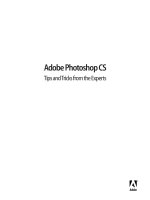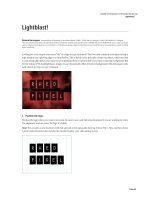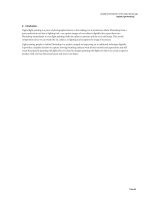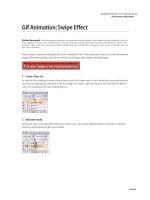Ebook Mohs surgery and histopathology: Beyond the fundamentals - Part 1
Bạn đang xem bản rút gọn của tài liệu. Xem và tải ngay bản đầy đủ của tài liệu tại đây (8.74 MB, 90 trang )
MOHS SURGERY
AND HISTOPATHOLOGY:
BEYOND THE FUNDAMENTALS
MOHS SURGERY is a highly effective technique for the surgical removal of most types of
cutaneous and oral pharyngeal cancers. The procedure allows for the precise and complete
removal of cancers while maximizing the preservation of surrounding normal tissue. Through
the presentation and orientation of the specimens’ complete surgical margin on pathology
slides, the location of tumor foci and other relevant findings can be correlated with their locations on the surgical wound. The ability to create perfect slides for histological examination
lies at the core of effective Mohs surgery. This procedure has the highest cure rate among
alternative cancer treatment modalities for the cancers for which it is utilized. This book
describes the methods the Mohs surgeon-pathologist and Mohs technician use to optimize
the Mohs technique and produce the highest-quality slides and highest cure rates possible,
and it breaks new ground in describing techniques that the Mohs technician uses in the lab.
Ken Gross, MD, is non-salaried Clinical Professor in the Division of Dermatology at the
University of California, San Diego School of Medicine, San Diego, and is also in private
practice limited to the treatment of skin cancer in San Diego, California.
Howard K. Steinman, MD, is Director of Dermatologic and Skin Cancer Surgery and Associate Professor of Dermatology at the Texas A&M University Health Sciences Center College of Medicine, Scott and White Medical Center, Temple, Texas.
MOHS SURGERY
AND
HISTOPATHOLOGY:
BEYOND THE
FUNDAMENTALS
Edited by
Ken Gross
University of California, San Diego School of Medicine
San Diego, California
Howard K. Steinman
Texas A&M University Health Sciences Center College of Medicine
Temple, Texas
CAMBRIDGE UNIVERSITY PRESS
Cambridge, New York, Melbourne, Madrid, Cape Town, Singapore,
São Paulo, Delhi, Dubai, Tokyo
Cambridge University Press
The Edinburgh Building, Cambridge CB2 8RU, UK
Published in the United States of America by Cambridge University Press, New York
www.cambridge.org
Information on this title: www.cambridge.org/9780521888042
© Cambridge University Press 2009
This publication is in copyright. Subject to statutory exception and to the
provision of relevant collective licensing agreements, no reproduction of any part
may take place without the written permission of Cambridge University Press.
First published in print format 2009
ISBN-13
978-0-511-58091-8
eBook (NetLibrary)
ISBN-13
978-0-521-88804-2
Hardback
Cambridge University Press has no responsibility for the persistence or accuracy
of urls for external or third-party internet websites referred to in this publication,
and does not guarantee that any content on such websites is, or will remain,
accurate or appropriate.
Every effort has been made in preparing this book to provide accurate and up-todate information that is in accord with accepted standards and practice at the time
of publication. Although case histories are drawn from actual cases, every effort
has been made to disguise the identities of the individuals involved. Nevertheless,
the authors, editors, and publishers can make no warranties that the information
contained herein is totally free from error, not least because clinical standards are
constantly changing through research and regulation. The authors, editors, and
publishers therefore disclaim all liability for direct or consequential damages
resulting from the use of material contained in this book. Readers are strongly
advised to pay careful attention to information provided by the manufacturer of
any drugs or equipment that they plan to use.
I hope this book will eventually find its way to the bookshelf equivalent of the “dustbin of history,” as
targeted immunotherapy and other evolving cancer treatments replace the surgical model employed today.
Even a procedure as elegant as Mohs surgery will find its rightful place alongside other outdated surgical
techniques. I hope the transformation happens in my lifetime.
To Ruth Gross and Edith Chepin: two peas in a pod enjoying their tenth decade of life.
KGG
To Barry Goldsmith, for patiently and thoughtfully teaching me Mohs surgery.
To the many Mohs surgery course participants for showing me how to better practice and teach our craft.
And most assuredly to Robert and Madeline, now gone, and Diedre and our sons, Adam and Steven, sine
qua nons, for their boundless love, encouragement, support, and humor, which gives foundation,
perspective, joy, and contentment to my life.
HKS
Our dear friend and colleague, Terry O’Grady, who died during the preparation of this book,
will be greatly missed.
KGG and HKS
Contents
C ONTRIBUTORS
Chap. 7. LAB PEARLS: STAINING, INKING,
AND COVERSLIPPING 57
Alex Lutz
ix
PART I
MICROSCOPY AND TISSUE PREPARATION 1
Chap. 8. LAB PEARLS: TROUBLESHOOTING
SLIDE QUALITY 62
Alex Lutz
Chap. 1. INTRODUCTION 3
Ken Gross and Howard K. Steinman
Chap. 2. HOW TO EXCISE TISSUE FOR OPTIMAL
SECTIONING 5
Ken Gross
Chap. 9. MOHS SLIDES ORGANIZATION AND
STANDARDIZATION FOR EFFECTIVE
INTERPRETATION 67
Ken Gross
Chap. 3. OPTIMIZING THE MOHS
MICROSCOPE 15
Ken Gross
Chap. 10. MOHS MAPPING
Howard K. Steinman
Chap. 4. TISSUE PREPARATION AND
CHROMACODING 21
Howard K. Steinman
PART III
MICROANATOMY AND NEOPLASTIC
DISEASE 83
Chap. 5. EMBEDDING TECHNIQUES
Edward H. Yob
27
Chap. 11. NORMAL MICROANATOMY: VERTICAL
AND HORIZONTAL 85
John B. Campbell
PART II
INTRODUCTION TO LABORATORY
TECHNIQUES 35
Alex Lutz
Chap. 12. BASAL CELL CARCINOMA: VERTICAL
AND HORIZONTAL 96
A. Neil Crowson and Carlos Garcia
Chap. 13. SQUAMOUS CELL CARCINOMA:
VERTICAL AND HORIZONTAL 109
A. Neil Crowson and Edward H. Yob
Chap. 6. LAB PEARLS: MAKING GREAT
SLIDES 37
Alex Lutz
PREPARING SLIDES WITH CARTILAGE
Michael Shelton
78
Chap. 14. UNUSUAL TUMORS: VERTICAL AND
HORIZONTAL 118
Terence O’Grady
52
vii
viii
C ONTENTS
Chap. 15. MOHS FOR MELANOMA 129
Adam J. Mamelak and Arash Kimyai-Asadi
Chap. 16. TAKING STAGES BEYOND STAGE I 138
Tri H. Nguyen
Chap. 17. PERINEURAL TUMORS 142
Alexander Miller
Chap. 19. TOLUIDINE BLUE STAIN FOR MOHS
MICROGRAPHIC SURGERY 155
Ofer Arnon, Adam J. Mamelak, and Leonard H. Goldberg
Chap. 20. FORMS AND TEMPLATES FOR
MOHS SURGERY 161
Ken Gross and Howard K. Steinman
I NDEX
PART IV
SPECIAL TECHNIQUES AND STAINS 149
Chap. 18. FIXED-TISSUE MOHS 151
Laura T. Cepeda, Daniel M. Siegel, and
Norman A. Brooks
177
Contributors
Ofer Arnon, MD
Department of Plastic and Reconstructive Surgery
Soroka University Medical Center
Beer-Sheva, Israel
Division of Dermatology
Department of Medicine
University of California, San Diego School of Medicine
San Diego, California
Norman A. Brooks, MD
Skin Cancer Medical Center
Encino, California
Arash Kimyai-Asadi, MD
DermSurgery Associates
Houston, Texas
John B. Campbell, MD
Pacific Pathology
San Diego, California
Alex Lutz
Travel Tech Mohs Services, Inc.
Torrance, California
Laura T. Cepeda, MD
Long Island Skin Cancer & Dermatologic Surgery
Smithtown, New York
Adam J. Mamelak, MD
Department of Dermatology
The Methodist Hospital
Houston, Texas
A. Neil Crowson, MD
Departments of Dermatology, Pathology, and Surgery
University of Oklahoma and Regional Medical
Laboratories
St. John Medical Center
Tulsa, Oklahoma
Alexander Miller, MD
Department of Dermatology
University of California, Irvine
Irvine, California
Private Practice, Dermatology
Yorba Linda, California
Carlos Garcia, MD
Department of Dermatology
University of Oklahoma
Oklahoma City, Oklahoma
Tri H. Nguyen, MD
Departments of Dermatology and Otorhinolaryngology
The University of Texas MD Anderson Cancer Center
Houston, Texas
Terence O’Grady, MD†
Division of Dermatology
Department of Medicine
University of California
San Diego School of Medicine
San Diego, California
Leonard H. Goldberg, MD
DermSurgery Associates
Houston, Texas
Ken Gross, MD
Private Practice, Dermatologic Surgery
San Diego, California
†
ix
deceased
x
C ONTRIBUTORS
Michael Shelton
Skin Surgery Medical Group, Inc.
San Diego, California
Daniel M. Siegel, MD
Long Island Skin Cancer & Dermatologic Surgery
Smithtown, New York
Howard K. Steinman, MD
Texas A&M University Health Science Center College
of Medicine
Scott and White Medical Center
Temple, Texas
Edward H. Yob, DO
Department of Dermatology
University of Oklahoma
Oklahoma City, Oklahoma
Dermatology Associates of Tulsa, LLC
Tulsa, Oklahoma
MOHS SURGERY AND HISTOPATHOLOGY
PART ONE
MICROSCOPY
AND
TISSUE
PREPARATION
CHAPTER 1
Introduction
Ken Gross and Howard K. Steinman
MOHS SURGERY will remain the gold standard for the
treatment of skin cancer until immunotherapy or other
nondestructive modalities replace current surgical treatments. It allows skin cancer removal with higher cure rates
and greater sparing of normal tissues than other excisional
techniques. Mohs surgery accomplishes this in an office
setting and at reasonable cost when practiced in an optimal
fashion.
There are some common misconceptions about Mohs
surgery that may stand in the way of optimizing the technique and that may unnecessarily increase its cost.
MISCONCEPTION 1
Mohs surgery is first and foremost about tissue sparing. It is not; Mohs surgery’s first goal is complete cancer
removal. A focus on tissue sparing leads some Mohs surgeons to excise specimens with very narrow surgical margins even from areas where taking wider margins would
not compromise function or closure. There are clearly
many situations where excising wider margins would allow
fewer stages of surgery, lower surgical costs, and would not
substantively change the type of closure or lead to any
cosmetic or functional degradation. In addition, if tissue
sparing were the main goal of treatment, other modalities such as cryotherapy, radiation, and in selected cancers,
presently available immunotherapy such as interferon alfa2b and imiquimod would spare tissue to a greater extent
while compromising cure rates by less than 5–10%.
and produce more high-quality wafers from each block,
thus allowing easier orientation and interpretation at lower
cost.
MISCONCEPTION 3
Because Mohs surgery presumably allows for precise
examination of approximately 100% of the tissue margins and precise localization of tumor foci, only minimal overlap of areas adjacent to positive findings needs
to be excised. While Mohs surgery has more built-in
precision than other cancer surgical modalities, there is
plenty of room for small errors, which can be additive.
For this reason, a wider margin around positive foci is
sometimes rewarding to the surgeon and beneficial to the
patient.
MISCONCEPTION 4
“Good enough is good enough.” The strength of Mohs
surgery is that it examines approximately 100% of the true
surgical margin. If complete base and epithelium (when
available) are not represented on the slides, then 100%
margin assessment has not been done and more sectioning
through the block or obtaining more tissue from the patient
is necessary. This is also an argument against doing vigorous curettement prior to the first stage of Mohs surgery:
it may disrupt the peripheral epidermis, leading to incomplete peripheral margin on the slides.
MISCONCEPTION 5
MISCONCEPTION 2
Specimens need to be divided into many subsections
(blocks) to allow optimal processing. This leads to relatively small specimens being divided into more than five
tissue blocks for processing, which increases the cost and
complexity of the procedure and the potential for processing and interpretation errors. It is more beneficial to process the largest blocks your technician and equipment allow
Mohs surgery is difficult to perform and requires
extensive training. Mohs surgery differs from other types
of skin cancer excisional surgery only in a few aspects:
1. It is highly organized and system dependent, requiring
excision of tissue to allow optimal processing of the complete, contiguous surgical margin and a highly skilled
technician to prepare quality slides.
page 3
4
M OHS S URGERY
AND
H ISTOPATHOLOGY
2. It requires accurate pathologic interpretation of horizontally cut tissue (see Chapter 11) in contrast to
vertically oriented tissue normally reviewed on pathologic and dermatopathologic slides.
3. It requires the surgeon to assess the pathologic slides as
well as perform the surgery.
The greatly advanced surgical skill set of many dermatologists, improved surgical training opportunities, modern surgical instruments, better local anesthetics, improved
agents and devices for hemostasis, and better patient monitoring and resuscitation equipment make the surgeon’s job
easier and faster. Modern cryostats, chromacoding inks and
stains, improved automated tissue processing, and better
microscopes have all combined to make slide preparation
faster, quality better, and interpretation easier than ever
before.
It is therefore reasonable to assume that a higher degree
of accuracy is possible in utilizing the Mohs technique today
than has been in the past. In assessing the relative value
of more surgical training versus more pathology training
for a dermatologist (or any other physician) wishing to
perform Mohs surgery, an additional year of pathology
study might be of more value than an additional year of
surgical training – although this is viewed with reservations, as one of the justifications for a Mohs fellowship is
to allow the pathologic and clinical review of hundreds of
Mohs cases. In either case, additional training is of value.
We would argue that dermatologic residency training usually does, and always should, provide the training in skin
surgery and skin pathology that allows the performance
of a basic level of Mohs surgery within a dermatologic
practice.
Mohs surgery is a cancer removal modality and defect
repair may be done by the Mohs surgeon or another surgeon, and wounds may be allowed to heal by second intention.
MISCONCEPTION 6
Mohs surgery is like a religion with inviolable precepts dictating who may perform it and how it must
be performed.∗ The only absolute precept is that, as
closely as possible, 100% of the true surgical margin must
be accurately assessed to ensure complete removal of the
cancer. There is no specific way in which the technique
must be performed. Mohs surgery obviously cannot deal
with discontiguous tumors, cancer cells that have already
left the surgical field, or occult satellite and /or in-transit
metastasis. Whichever reliable and reproducible method
the Mohs surgeon selects to accomplish the goal of 100%
margin assessment and complete cancer removal should be
accepted, politics aside. Although sparing normal tissue is
an important virtue of Mohs surgery, the one true goal of
Mohs surgery is curing the cancer. It is the ability of properly performed Mohs surgery to achieve a high cure rate
that allows it to be the premier technique for the removal of
skin cancer. How exactly to optimize Mohs surgery techniques that allow the Mohs surgeon to reproducibly and
consistently produce these high cure rates is just detail.
These details are what this book is about. We assume that
the reader of these pages has a basic understanding of Mohs
surgery or has read Mohs Surgery: Fundamentals and Techniques.1
REFERENCE
1.
∗
Gross KG, Steinman HK, Rapini RP. Mohs Surgery: Fundamentals and Techniques. St. Louis, Mo: CV Mosby Co; 1998.
(The book may be ordered from ASMS (800) 616-ASMS.)
The requirement that the Mohs surgeon must also be the Mohs pathologist is arbitrarily based only on CPT regulations. No other cancer surgery
excludes the participation of pathologists or dermatopathologists from
helping interpret pathology specimens.
CHAPTER 2
How to Excise Tissue
for Optimal Sectioning
Ken Gross
THE GOAL OF MOHS surgery is to cure skin cancer.
Optimization of Mohs surgery ensures that the high cure
rates available with this technique are achieved in practice.
Production of the highest-quality Mohs slides makes possible the most accurate interpretation of the surgical margins represented on those slides. The Mohs surgeon, by
optimizing tissue excision at the operative table, allows the
Mohs technician to produce high-quality slides that present
complete surgical margins of all excised tissue.
A masterful Mohs technician may be able to salvage
tissue excised with poor surgical technique, and a poor
technician can make garbage from an exquisite surgical
specimen. In this chapter we focus on issues of surgical technique that will help the competent Mohs technician prepare better slides and allow faster and more cost-effective
Mohs surgery. Optimizing surgical technique allows for
the most favorable slide preparation. The Mohs surgeon,
when switching hats and becoming the Mohs pathologist,
will then have the best chance of making accurate surgical
margin assessments.
HOW TO EXCISE TISSUE FOR OPTIMAL
SECTIONING
Even before making the first incision, the Mohs surgeon
can increase the chance for complete cancer removal in as
few stages as possible. The clinical margins of the tumor
should be assessed with bright light and magnification. Use
of an episcope and Wood’s light may help define the margins of some cancers, especially pigmented lesions. Reassess the clinical margins after injection of anesthesia, as
tumor margins may become more distinct after injection.
Small ink dots can be drawn on the skin around the cancer
to define the clinical cancer margins. Three decisions must
then be made:
1. Should curettage be done to help further define the margins?
2. Should the cancer be debulked?
3. How much surgical margin past the clinical tumor
should be removed?
Curettage prior to stage I cancer removal may help
define the tumor margin and also debulks the cancer, but
the downside of curettage is possible removal of some of
the epithelial edge, especially in older patients with fragile skin. This makes margin assessment more difficult and
may require a wider surgical margin around the disrupted
epithelium.
Debulking is primarily done in two situations:
1. When there is a large bulky exophytic tumor, debulking the tumor makes tissue processing easier. As this
is done sharply and should not extend to the specimen
margins, there should be no loss of epithelial edges. If the
Mohs surgeon debulks using a surgical scalpel, the blade
must be wiped thoroughly free of tumor fragments, or
changed, before excising stage I tissue. The Mohs technician may also debulk tissue in the laboratory, also thoroughly wiping the blade or using a separate blade before
processing the specimen, to prevent artifactual tumor
“floaters” from appearing on the slides.
2. To produce a vertically oriented slide of the tumor
pathology when a previous biopsy is unavailable or has
not been done. Having the tumor pathology available is
very helpful for accurate slide interpretation.
Since Mohs surgery is most often performed following a
diagnostic biopsy, there is frequently a “scab” on the cancer
site. In large or deep cancers this scab is of no consequence,
but in small and relatively shallow tumors it will interfere
with the production of high-quality slides. It should be
removed by the surgeon or technician prior to processing
the tissue.
The issue of how much margin to take past clinically
evident tumor is influenced by several factors:
1. Will removal of margin past the clinically clear margin
cause a functional defect?
page 5
6
M OHS S URGERY
AND
H ISTOPATHOLOGY
45°
Epidermis
45°
Dermis
Fat
Fascia
A
Excision
margin
B
FIGURE 2.1: (A) The bevel is continued to the level at which the horizontal base of the
specimen is to be cut, or to the level at which closure will be done, if that is deeper.
On the arm, the Mohs surgeon would carry the bevel to the level of the fascia, as
undermining and repair will usually be done at that level (left). On most areas of the face,
the bevel would be cut to superficial fat (right), unless it is clinically obvious that the
tumor is deeper, because that is the level at which undermining and closure will be done.
(B) The specimen should be undermined from all edges toward the center and not from
one edge through to the other side. Curved arrows (left) indicate that the Mohs surgeon is
correctly cutting the specimen from all sides toward the center. Straight arrows (right)
indicate that the Mohs surgeon is incorrectly cutting the specimen from the 9 o’clock side
straight through to the other side. This is likely to lead to an unevenly cut specimen base
and an irregularly beveled peripheral margin.
2. Will removal of additional peripheral margin increase
the difficulty or morbidity of the closure?
3. Will removal of additional deep tissue margin compromise the function of a motor nerve or other important
underlying structure?
If a smaller margin is taken around the tumor for any of
these reasons, the cure rate is not compromised because
any positive margin will be removed in a subsequent
stage.
The primary purpose of Mohs surgery is to achieve a
high cancer cure rate. When necessary, it also has the ability to spare tissue. But this ability is subject to abuse. A
small but poorly clinically demarcated sclerosing basal cell
in the mid-to-lateral cheek can be removed to below midfat with little risk of damage to underlying structures; and a
peripheral surgical margin of 5 mm or more, as opposed to
1–2 mm, will be unlikely to cause closure or cosmetic problems. This would not be true for the excision of the same
tumor on the lip or eyelid. Here, the ability of Mohs surgery
to spare tissue shares equal importance with its ability to
achieve a high cure rate.
The Mohs technique usually requires that the edges of
the specimen(s), which in stage I are epidermal or mucosal,
be flattened into the same plane as the base during processing (see Chapter 6 through 8). This allows the entire deep
and peripheral margins to be represented contiguously
within the tissue wafers. To allow the technician to more
easily flatten the tissue into a single plane for sectioning, the
Mohs surgeon generally excises specimens at an approximately 45-degree angle (bevel). In the excision of large
specimens, this angled cut continues only to the deepest
plane of excision. At the deepest plane, the rest of the excision is horizontal (Figure 2.1A). To ensure as uniform a
bevel and as flat a base as possible, the specimen should be
cut from all sides toward the center and not from one edge
continuously through to the other side (Figure 2.1B).
Although a 45-degree bevel is often stated to be ideal,
many thin tissue areas such as the eyelid, genitalia, neck,
and mucosa require little or no beveling. Thick, stiffer tissue areas, such as the back, may require more of a bevel (an
angle of 30 to 40 degrees). As excisions progress deeper,
the scalpel traverses first the epithelium and dermis, then
fat, fascia, muscle, and periosteum. These tissues have differing abilities to flatten during tissue processing; thus, the
amount of bevel needed to produce optimal slides will also
change. Specimens of smaller diameter may be more difficult for the technician to flatten than larger specimens
Chapter 2
●
How to Excise Tissue for Optimal Sectioning
7
Top view of
small specimen
Epidermis
30°
Level at which closure
will be carried out
Tumor
A
Top view of
large specimen
Tumor
30°
45°
Fascial plane
of closure
B
FIGURE 2.2: (A) Because the specimen is small, a beveling angle of 30 degrees instead of 45 degrees
may be necessary to allow the technician to flatten the edges and base of the specimen into a single
plane for processing, and the excision may be carried down only to a level above the level at which the
defect would be undermined for closure. (B) The excision of a larger-diameter cancer may allow a
steeper bevel that can be extended all the way down to the plane of eventual closure. If the cancer is
obviously deeper than this plane, the excision may be carried even deeper. “Standard” surgical
technique of cancer uses vertically cut specimens. Mohs surgery uses cuts made at a bevel; this bevel
allows the technician to flatten the edges of the specimen into the same plane as the base so that the
entire peripheral and deep margin can be completely assessed pathologically. The usual bevel is 45
degrees from the standard vertical cut and yields a specimen whose sides are cut at 45 degrees from
the horizontal surface of the specimen (left). A larger bevel would produce a specimen whose sides
are cut at a smaller number of degrees from the flat surface of the specimen (right). The 30-degree
bevel makes it easier for the Mohs technician to flatten the specimen into a single plane for
processing but also increases the chances that the bevel cut will transect cancer.
and may require more of a bevel; either a wider surgical
margin is required or they may not be able to be excised as
deeply (Figure 2.2). This is a small disadvantage of Mohs,
as opposed to standard excision technique.
When possible, the first stage in Mohs surgery should be
cut to the depth of eventual closure (Figure 2.1A). This is
limited by the surface dimensions of the excised specimen.
A small-diameter specimen cut at a bevel of 45 degrees may
not be able to be adequately flattened into a single plane
by the technician and would likely reach a depth less than
the probable final plane of wound closure before the base
of the specimen is completely cut. To initially cut a large
specimen above the depth that will be utilized for closure
increases the chance of leaving cancer at the deep margin,
increases surgical time and cost, and does not spare tissue,
as undermining and closure in the proper plane will likely
require removal of this deep tissue that was “spared” during
the Mohs procedure. Thus, for example: scalp excisions
should be carried to subgalea, and extremity excisions to
muscle fascia.
In some situations, a sufficient bevel to allow optimal
processing of the specimen may not be achievable. This is
frequently true of deep but narrow alar crease tumors. If
specimens require deep tissue removal, but the specimen is
too narrow to allow an adequate bevel, the specimen can
be taken with little or no bevel and instead prepped by the
technician using the “open book” technique (Figures 2.3
and 2.4A–C).
This technique may also be used when re-excising a surgical scar after permanent section pathology has shown
a positive margin. The entire scar needs to be removed
to a deeper plane than the previous surgery and the
peripheral margin needs to be cut as widely as the area
was previously undermined. The open book technique
8
M OHS S URGERY
A
AND
H ISTOPATHOLOGY
B
C
FIGURE 2.3: (A–E) Clinically deep cancer
(A,B) in a thick skin area excised with steep
sides. The peripheral margins and base of the
tissue cannot be easily flattened into a single
plane (C); thus, the “open book” technique is
used. (D) Cutting of the specimen deep into
the central long axis; the tips at 9 o’clock and
3 o’clock will be cut through and through.
(E) The specimen is ready to be embedded
and cut; the “Pac-Man” back cuts at 9 o’clock
and 3 o’clock have been completely inked with
Mohs dye.
D
E
Excised specimen is cut with
steep sides which extend
deeply relative to size
.
.
.
. . .
+ + +
A
B
+
+
C
FIGURE 2.4: Diagrammatic illustration of the same type of excision as in Figure 2.3. The inking diagram
shows complete inking of the ends of the specimen, opened to allow flattening using the open book
technique. (A) Diagrammatic illustration for a cancer similar in type and location as in Figure 2.3. Excision
for this cancer cannot be easily done with standard beveling technique because, although clinically small,
the cancer is deep and located in a thick skin area. (B) The excised tissue has very steep edges and cannot
be flattened into a single plane using standard tissue relaxing incisions. Standard relaxing incisions would
not be enough to get the edges and base to lie in a single plane for sectioning. (C) “Pac-Man” cuts along
the long axis of the specimen (at 3 o’clock to 9 o’clock in this example) allow the specimen to “open like a
book” and all the edges to be flattened into a single plane for processing. The tips are cut all the way
through to further allow the specimen to lay flat. Tumor extending to the edges of the Pac-Man cuts is not
at a margin because this is an artificial edge produced by the technician. The true margins include the
entire base and the peripheral epithelial edges. The entire cut tips must be chromacoded so that the Mohs
surgeon-pathologist has a way to ensure that the tissue at these cut tips is completely represented.
Chapter 2
12
Clinical
tumor
Block 1
9
3
Block 2
●
How to Excise Tissue for Optimal Sectioning
9
FIGURE 2.5: (A) A large specimen is cut. The Mohs
surgeon should have but did not place the 3 o’clock
and 9 o’clock reference nicks at the midpoint of the
long axis of the specimen. (B) The technician has
subdivided the specimen into two equally sized blocks
but not at the 3 o’clock and 9 o’clock marks cut by
the surgeon. This makes it harder for the Mohs
surgeon-pathologist interpreting the findings on the
slides to transfer them to the proper location within the
excision defect on the patient because the 3 o’clock
and 9 o’clock reference nicks on the patient do not
correspond to where the technician subdivided the
specimen into two blocks.
6
A
B
works well for preparation of first-stage excisions of these
specimens.
The open book technique requires special care on the
part of the technician to ensure that in making cuts through
the specimen, tumor is not inadvertently carried by the
blade into the margins. Both ends of the specimen must also
be completely inked so that the Mohs surgeon-pathologist
is certain that complete surgical margins are represented
on the slides.
The surgeon should choose distances between reference
nicks (hatch marks) that attempt to correspond to the size
of the blocks the technician is able to process in a microtome (Figure 2.5); this allows easier translation of the exact
location of the tumor at a margin from the microscope
to the patient. The technician should attempt to subdivide the surgical specimen at the hatch marks placed in the
tissue by the surgeon, even if this results in not dividing
the specimen into blocks of equal dimensions (Figures 2.5
and 2.6).
FIGURE 2.6: This photo illustrates how the technician actually
processed the two blocks. The blocks are not of equal size; but
were subdivided by the technician at the reference nicks placed
on the specimen and on the patient by the surgeon. This will
make it easier for the Mohs surgeon-pathologist to translate
findings from the slides to the patient’s wound.
When dividing the specimen into multiple blocks, the
technician must ensure that tumor is not artifactually
carried to a margin where it could be misread as a positive margin. This probability may be reduced by debulking
obvious tumor from the top of the specimen, by cutting
from the specimen edges toward the center, and by wiping
the blade after each cut (see Chapters 6, 7, and 8). Likewise, the surgeon should wipe the scalpel blade frequently
when making excisions to preclude carrying cancer from a
clinically occult area of the tumor to a tumor-free area. In
Mohs surgery, the surgeon only knows in retrospect that
the area being cut is cancer-free.
The Mohs surgeon must determine where to designate
“12 o’clock” on the excised specimen. How each surgeon
does this is not as important as consistency in a chosen
method, so that even if a reference nick is not seen at the
edges of the wound when the patient is brought back for
additional cancer excision stages, the Mohs surgeon still
has at least a general idea of where the 12 o’clock reference
nick might have been. This may allow excision of that Mohs
stage with only slightly greater than usual overlap (Figure 2.7). In some practices, 12 o’clock may always point
superiorly, medially, and/or posteriorly. Other surgeons
may always orient 12 o’clock toward the tip of the ear lobule on the side of the body where the cancer is located.
Many other methods are equally valid. A digital photo (Figure 2.8) taken of the ink outline and reference nicks of the
area to be excised can be viewed later on the camera, or
printed, if confusion exists in the surgeon’s mind.
As well as choosing where 12 o’clock will be on the tissue specimen, the Mohs surgeon must also ensure that clear
orientation of the specimen is maintained from the operative table to the technician’s inking station. This can be
done in a number of ways:
1. Prior to making the final cut of the base of the specimen, the surgeon-pathologist should visually double
check that the reference nicks can be clearly seen on
the specimen and corresponding wound edges.
10 M OHS S URGERY
AND
.
H ISTOPATHOLOGY
. .
.
.
+
A
B
FIGURE 2.7: (A) Mohs specimen cut with a 12 o’clock superior
orientation. Cancer is noted at the 12 o’clock margin on the
Mohs slide from this excision, but, unknown to the surgeon, the
reference nicks did not “show” on the patient’s skin after the
specimen was removed. (B) No reference marks were visible
when the surgeon-pathologist returned to the operative table
and viewed the patient’s wound. This surgeon always uses
12 o’clock as superior orientation and has a preop digital photo
of the area with the tumor outlined and reference nicks
demarcated with ink; therefore, in this example, the correct
margins are easily ascertained by the surgeon-pathologist and
a correct stage II excision easily determined. It is not always
this easy.
2. An arrow from the sterilization indicator strip can be cut
and the specimen placed on the arrow so that 12 o’clock
lies in the same direction as the tip of the arrow (Figure 2.9).
3. A blood and/or ink dot on a corner of the transfer gauze
can be used to designate the 12 o’clock margin.
FIGURE 2.8: Photo of a large cancer with the reference nicks
drawn; the subdivision of the tissue into smaller blocks for
processing will be done at these hatch marks.
4. For large and/or complex specimens, digital photographs should be taken and printed of the specimen
before lifting it from the wound, and again with the
specimen removed but placed next to the defect (Figure 2.10); this will show the new shape of both the specimen and defect, both of which change shape after the
specimen is removed. Because the Mohs map is intended
to depict the patient’s wound after the removal of the
tissue specimen, some Mohs surgeons don’t draw their
maps until after the specimen is excised.
When excising cartilage, including some noncartilaginous tissue at one or more of the specimen edges will help
the technician prevent the cartilage from “floating” off the
slides during processing. Even if this results in a slightly
larger defect, it can be so helpful in producing betterquality slides that the net result is usually worthwhile.
(See also Chapter 6 for techniques for slide preparation
of tissue containing cartilage.)
Chapter 2
●
How to Excise Tissue for Optimal Sectioning
11
FIGURE 2.9: A piece of sterilization indicator strip cut as an
arrow with the specimen is laid upon the “arrow” so that the
arrow point and the specimen’s 12 o’clock reference nick are
oriented in the same direction.
When excising large specimens from the vermillion or
helix, it is sometimes best not to bevel. Cutting straight
through the tissue without beveling allows these cut ends
to be processed more easily (Figure 2.11).
When excising a positive margin, the surgeon should
significantly overlap beyond the diagrammed extent of the
positive margin unless this will cause significant functional
postoperative problems.
It is critical to understand that sometimes the location
of a deep positive tumor margin noted within a Mohs
wafer on a slide, and then depicted on the two-dimensional
(2D) Mohs map may be incorrectly located within the
three-dimensional (3D) wound when the Mohs surgeonpathologist returns to the surgical table. A deep positive
margin in a 2D flattened specimen may actually lie on or
partially on the wall of the 3D wound, not only at its base.
This will require the removal of both additional peripheral
A
B
FIGURE 2.11: This specimen from the helix of the ear has been
cut at both ends without a bevel. The technician will have to cut
both ends across their short axes in a partial “bread loaf”
FIGURE 2.10: A large specimen is photographed next to
the wound from which it was cut. This allows the Mohs
surgeon-pathologist to easily see the relationship between the
specimen and the wound, both of which change shape after
excision.
and deep margins within the patient’s wound (see Chapter 9).
Tumor in a nerve at the deep/central margin of a specimen requires excision of additional peripheral margin as
well as deep margin because nerves may run in any direction
and at any angle from vertical to horizontal. Furthermore,
additional nerve must be seen on slides from the next Mohs
stage (and be assessed as free of cancer) for the margins to
be interpreted as clear. If no nerve tissue is present on the
slides, that stage of surgery cannot be considered clear even
C
technique to allow the ends to lie in the same plane as the base.
The specimen from the lip has been excised similarly.
12 M OHS S URGERY
AND
H ISTOPATHOLOGY
1. For very large specimens, the specimen may be inked on
a clean piece of white paper or gauze, which is then saved
until slide evaluation is completed. The paper or gauze
depicts the chromacoding pattern to safeguard against
disagreement during slide review between the Mohs
map and the chromacoding on the slides. When done
properly, the chromacoding on the slides (when looking
through the microscope) is identical to that depicted on
the map.
2. A digital photograph of the specimen taken immediately after inking but before any further processing may
also be used to resolve later chromacoding issues (Figure 2.12).
FIGURE 2.12: Inking pattern of a large complex specimen. The
inking was done on towel paper, which is saved until the case is
completed. Both the photo and the paper towel will show
exactly how the chromacoding was performed by the
technician, and may be used to resolve later chromacoding
issues.
if no cancer or perineural inflammation is seen (see Chapter 17).
Ensuring the integrity of chromacoding is critical, especially when large and/or complex specimens are taken (see
Chapter 4). The surgeon must play an active role in this
process:
Some Mohs surgeons do the chromacoding in the operating room, while others allow the technician to do the
chromacoding (see Chapter 4). On large deep cancers
requiring multiple stages, and for complex-shaped specimens, the Mohs surgeon should employ techniques to
ensure that the location of all pathologic findings noted
on the slides can be translated accurately to the defect so
that any areas with positive margins are accurately and completely removed in further stages.
Digital photography produces instant documentation of
the tissue to be excised before it is completely removed from
the patient. A second photo taken of the resulting defect
with the excised tissue held next to the defect allows the
surgeon to clearly see the relationships between the areas
Tumor
.
. .
.
.
.
.
.
.
+
+
++
A
+
B
FIGURE 2.13: (A) Stage I specimen with reference nicks at
12–3–6–9 o’clock. (B) Stage II specimen overlaps the positive
margin. The 12 o’clock and 3 o’clock reference nicks remain, but
new reference nicks (green) at 10:30 and 4:30 mark the extent of
stage II excision. The two new reference nicks are on the patient
and not the specimen because they mark only the extent of the
new stage II excision and could not be seen on the specimen.
The squiggly line seen in (B) is how this Mohs surgeon
represents a nonepithelial, surgically cut edge on the Mohs
map. Others may represent this differently but it is important to
annotate on the Mohs map where a surgical margin does not
+
C
contain epithelium. (C) Stage III specimen with a new reference
nick between 12 o’clock and 3 o’clock (green). The nick was
placed at this point because without it, the increasing distance
between the existing 12 o’clock-to-3 o’clock reference nicks
would have made the Mohs surgeon-pathologist’s job of
translating the exact location of a positive margin in this area
from the slides to the patients’ wound more difficult and less
accurate. This new reference nick is on the specimen and the
patient’s skin. Notice that the positive margins are significantly
overlapped in each subsequent stage.









